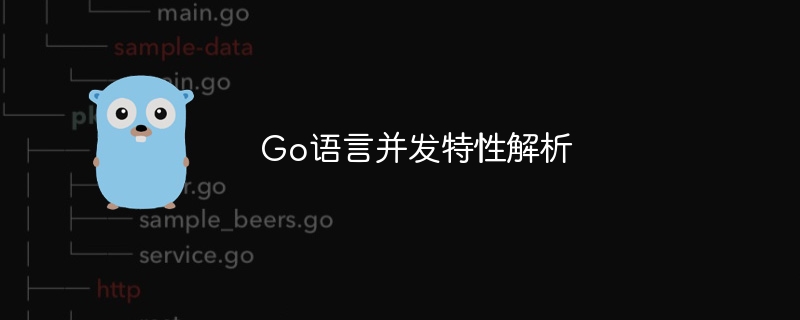

Go language concurrency feature analysis
Go language, as an open source programming language developed by Google, has unique advantages in handling concurrent programming. Due to its simplicity, efficiency and powerful concurrency mechanism, Go language is increasingly favored by developers. This article will deeply explore the concurrency features of Go language, including goroutine, channel and concurrency primitives, and analyze it with specific code examples.
1. Goroutine
In Go language, goroutine is the basic unit of concurrency, similar to threads, but more lightweight than threads. Goroutine is started using the go keyword, which can create thousands of goroutines for concurrent execution in the program without causing the exhaustion of system resources.
The following is a simple goroutine example:
package main
import (
"fmt"
"time"
)
func sayHello() {
for i := 0; i < 5; i++ {
fmt.Println("Hello")
time.Sleep(100 * time.Millisecond)
}
}
func main() {
go sayHello()
time.Sleep(500 * time.Millisecond)
}In the above example, a goroutine is started by go sayHello(), making sayHello() Functions can be executed concurrently. Let the main goroutine wait for a period of time through time.Sleep() to ensure that the goroutine has enough time to execute. Running the program will see "Hello" printed 5 times.
2. Channel
In the Go language, channel is a communication bridge between goroutines, which allows data to be transferred safely between goroutines. Channel needs to specify the data type when declaring it, which can be a basic type or a custom type.
The following is an example of using channels for communication:
package main
import (
"fmt"
)
func writeToChannel(ch chan string) {
ch <- "Hello, this is from channel!"
}
func main() {
ch := make(chan string)
go writeToChannel(ch)
msg := <-ch
fmt.Println(msg)
}In the above example, a string type channel is first created by make(chan string) , and pass it to the writeToChannel() function. In writeToChannel(), write data to the channel through ch <- "Hello, this is from channel!". In the main goroutine, use <-ch to read data from the channel and print it out. Running the program will see "Hello, this is from channel!" printed out.
3. Concurrency primitives
The Go language provides some primitives for controlling the behavior of goroutines, the most commonly used of which are Mutex and WaitGroup in the sync package.
Mutex is used to protect shared resources and avoid simultaneous access by multiple goroutines.
package main
import (
"fmt"
"sync"
"time"
)
var counter int
var mutex sync.Mutex
func increment() {
mutex.Lock()
defer mutex.Unlock()
counter++
fmt.Println(counter)
}
func main() {
var wg sync.WaitGroup
for i := 0; i < 10; i++ {
wg.Add(1)
go func() {
defer wg.Done()
increment()
}()
}
wg.Wait()
}
In the above example, sync.Mutex is used to protect the concurrent update of counter variables to avoid data inconsistency caused by simultaneous modification by multiple goroutines. Use sync.WaitGroup to wait for all goroutines to complete execution.
To sum up, the concurrency features of Go language make it easier for developers to write efficient, concurrency-safe programs. Through the combination of goroutine, channel and concurrency primitives, complex concurrent programming logic can be implemented. I hope this article can help readers gain a deeper understanding of the characteristics and practices of concurrent programming in Go language.
[Number of words: 664]
The above is the detailed content of Analysis of Go language concurrency features. For more information, please follow other related articles on the PHP Chinese website!
 Usage of Type keyword in Go
Usage of Type keyword in Go
 How to implement linked list in go
How to implement linked list in go
 What are the Go language programming software?
What are the Go language programming software?
 How to learn go language from 0 basics
How to learn go language from 0 basics
 What are the methods to implement operator overloading in Go language?
What are the methods to implement operator overloading in Go language?
 What are the operators in Go language?
What are the operators in Go language?
 getmonth() method
getmonth() method
 Why can't I access the Ethereum browser?
Why can't I access the Ethereum browser?
 java configure jdk environment variables
java configure jdk environment variables




